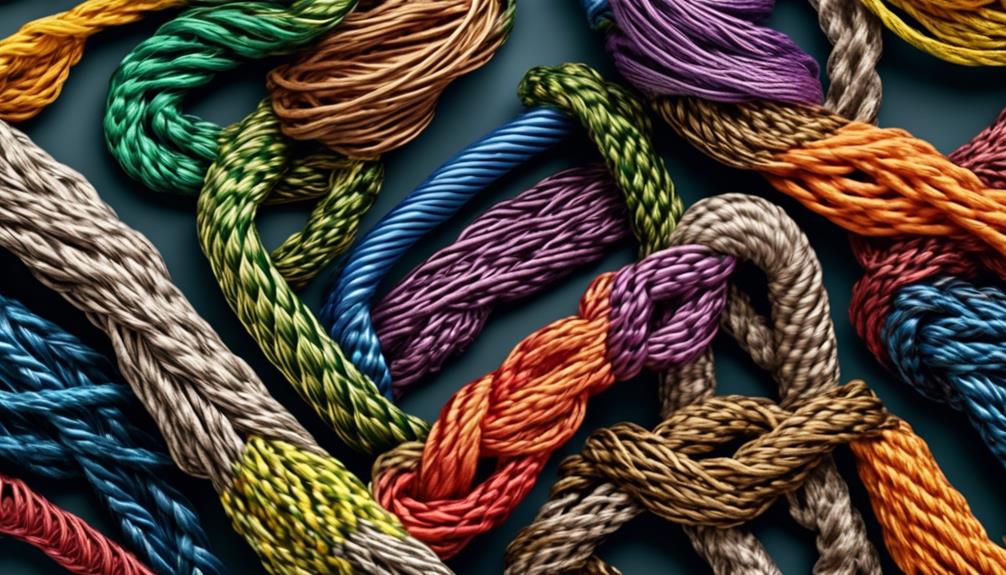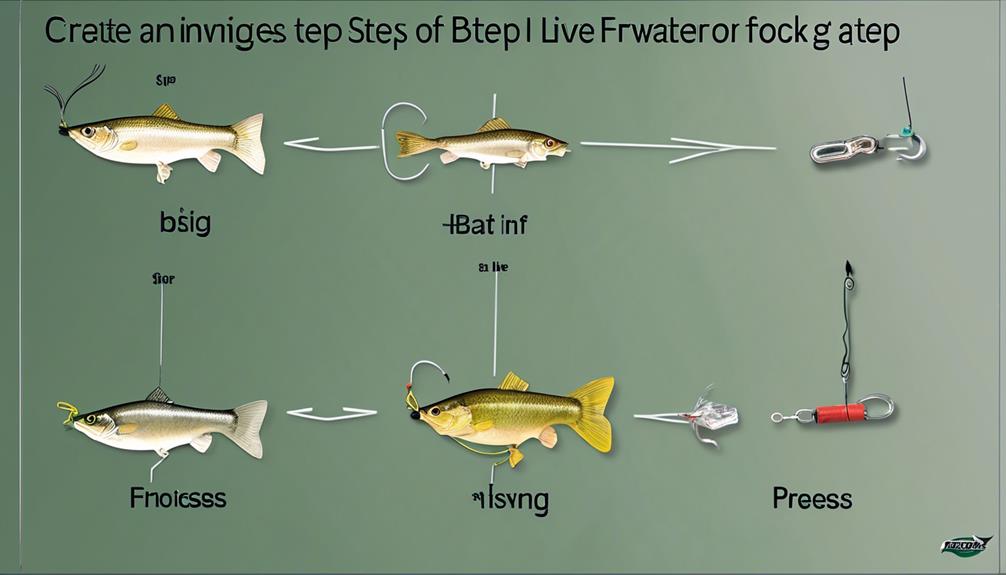Did you know that approximately 80% of lost fish are due to improperly tied knots? Understanding and mastering freshwater fishing knots is crucial for any angler looking to improve their success on the water.
Whether you're a beginner or an experienced fisherman, having a solid foundation in knot tying can make all the difference in your fishing endeavors. But there's more to it than just keeping your catch on the line.
Learning freshwater fishing knots can also enhance your overall fishing experience in ways you might not expect.
Importance of Knowing Freshwater Fishing Knots
Knowing freshwater fishing knots is crucial for ensuring that your line stays secure and your catch doesn't get away. The importance of mastering these knots can't be overstated.
Firstly, it significantly improves your technique. When you tie a strong and reliable knot, you can cast your line with confidence, knowing that it can handle the weight of your catch. This not only increases your chances of success but also enhances your overall fishing experience.
Additionally, understanding various knots contributes to safety. A well-tied knot prevents your line from slipping or breaking, reducing the risk of injury to yourself and others.
Moreover, it's essential for equipment care. Properly tied knots distribute the stress evenly across the line, preventing unnecessary wear and tear. This ensures that your gear lasts longer, saving you time and money in the long run.
Essential Freshwater Fishing Knots to Master
To become proficient in freshwater fishing, mastering essential knots is crucial for ensuring a secure and successful angling experience. Different types of knots serve various purposes, and understanding their applications is essential for any angler.
The improved clinch knot is a fundamental knot used to secure the fishing line to the fishing hook. It's relatively simple to tie and provides reliable strength.
The Palomar knot is another essential knot that's easy to tie and retains almost the full original strength of the line. This knot is particularly effective for securing hooks, lures, and swivels.
Additionally, the blood knot is indispensable for joining two lines together, especially when using lighter lines. It's a valuable knot for creating leaders and rigging up for various fishing techniques.
As you progress in your angling journey, mastering advanced techniques such as the double uni knot and the loop knot can significantly expand your capabilities.
The double uni knot is ideal for connecting lines of different diameters, making it useful for creating strong connections between the main line and leader.
On the other hand, the loop knot allows for greater freedom of movement for lures or bait, enhancing the presentation and action in the water. These knots are valuable tools in an angler's repertoire, providing versatility and adaptability in different fishing scenarios.
Advantages of Properly Tied Freshwater Fishing Knots
Mastering essential freshwater fishing knots not only enhances your angling skills but also provides numerous advantages when it comes to securing your fishing gear and maximizing your chances of a successful catch. Properly tied fishing knots are essential for securing your bait or lure to the line and for connecting various parts of your fishing gear. By mastering the art of knot tying, you can ensure that your knots are strong and reliable, preventing them from coming loose during a catch. This is crucial as it directly impacts your fishing technique, allowing you to focus on the actual act of fishing rather than worrying about your knots failing.
Furthermore, the strength of your fishing knots is vital in ensuring that you can reel in your catch without the fear of your line breaking. Proper tension in your knots is necessary to withstand the force exerted by the fish when it bites and struggles. This not only increases your chances of successfully landing a catch but also reduces the likelihood of losing expensive fishing gear due to poorly tied knots.
In essence, the advantages of properly tied freshwater fishing knots are clear. They provide the necessary strength and security to support your fishing technique, allowing you to focus on the thrill of the catch rather than the reliability of your knots. Therefore, investing time in mastering essential freshwater fishing knots is an invaluable aspect of becoming a skilled angler.
Step-by-Step Guide to Tying Basic Freshwater Fishing Knots
Start by carefully threading the end of the fishing line through the eye of the hook. Once you have completed this step, follow these simple instructions to tie basic freshwater fishing knots:
- Feel the Connection: As you tie the knot, visualize the bond between you, the line, and the fish. Sense the importance of a secure knot that will withstand the pull of a lively catch, and feel the excitement of a successful fishing adventure.
- Embrace the Challenge: Embrace the challenge of tying the knot manually, without the aid of knot tying tools or alternatives. Appreciate the simplicity and traditional skill involved in creating a strong knot, and take pride in mastering this essential fishing technique.
When you tie knots in a real-life scenario, such as attaching a lure or bait to your line, the practical applications of mastering basic freshwater fishing knots become evident. Imagine yourself on the edge of a serene lake, skillfully tying a secure knot as you prepare to cast your line into the water. Visualize the satisfaction of feeling a tug on the line, knowing that the knot you tied will hold strong, and the thrill of reeling in your catch.
These knots aren't just practical tools for fishing; they're essential elements that connect you to the experience of angling and the natural world.
Common Mistakes to Avoid When Tying Freshwater Fishing Knots
Avoid rushing through the process of tying freshwater fishing knots, as this can lead to common mistakes that compromise the strength and reliability of the knot. One of the most common errors is failing to moisten the knot before tightening. When you tighten the knot without lubrication, the friction can weaken the line and cause it to fray. Always remember to wet the knot with either saliva or water before pulling it tight.
Additionally, make sure to cinch the knot correctly. Many anglers make the mistake of only pulling one end of the line when cinching, which can lead to a lopsided and unreliable knot. Instead, hold the main line and the tag end, and slowly pull them in opposite directions to ensure a secure cinch.
Another frequently encountered mistake is using improper knot-tying techniques. It's essential to learn the right way to tie different knots for various fishing scenarios. Avoiding mistakes in this area involves improving your technique through practice and seeking guidance from experienced anglers or reliable sources.
Furthermore, failing to trim the tag end properly after tying the knot can result in the line getting caught on debris or the rod guides. To prevent this, remember to trim the tag end as close to the knot as possible without causing damage to it.
Tips for Choosing the Right Freshwater Fishing Knot for Different Situations
When selecting the right freshwater fishing knot for different situations, consider the specific characteristics of the fishing line and the type of fish you're targeting. Different fishing environments call for different knots, and understanding the strengths and weaknesses of each knot will help you make the right choice.
Here are some tips to help you choose the right freshwater fishing knot for different situations:
- Consider the Fishing Environment:
- If you're fishing in a weedy area, opt for a knot that can slide through vegetation without getting caught. This will help prevent your line from getting tangled and increase your chances of a successful catch.
- In rocky or abrasive environments, choose a knot that's known for its strength and resistance to abrasion. This will help prevent your line from breaking when rubbed against rough surfaces, giving you better control over your catch.
- Utilize Knot Tying Tools:
- Invest in a good pair of knot tying tools such as a knot-tying needle or a hook tier. These tools can make the process of tying certain knots much easier, especially in situations where dexterity is limited or the fishing line is particularly thick.
Understanding the Strength and Durability of Different Freshwater Fishing Knots

To ensure a successful angling experience, understanding the strength and durability of different freshwater fishing knots is crucial, especially in varying fishing environments where the right knot can make all the difference.
When it comes to freshwater fishing knots, strength comparison is a critical factor. Different knots have varying levels of strength, and understanding these differences can significantly impact your fishing success.
For example, the Palomar knot is known for its exceptional strength, making it a reliable choice when targeting larger species such as bass or pike. On the other hand, the improved clinch knot, while versatile, may not offer the same level of strength as the Palomar knot in certain situations.
Moreover, the strength of a knot is influenced by the properties of the material used. For instance, monofilament, fluorocarbon, and braided lines each have unique characteristics that affect knot strength.
Monofilament, with its flexibility and stretch, may require different knot choices compared to the low visibility and low stretch properties of fluorocarbon. Braided lines, known for their strength and sensitivity, also demand specific knot considerations due to their slick surface and thin diameter.
Understanding how these material properties interact with different knots is essential for maximizing the strength and durability of your freshwater fishing setups.
Practice Techniques for Perfecting Freshwater Fishing Knots
You can improve your freshwater fishing knot skills through consistent practice and attention to detail. Perfecting your knot tying is essential for successful fishing techniques, and here are some practice techniques to help you master the art of knot tying:
- Consistent Practice
Dedicate regular time to practice your knot tying skills. The more you practice, the more familiar and confident you'll become with different types of knots. This consistency will help you perform the knots effortlessly while fishing, even in challenging conditions.
- Attention to Detail
Pay close attention to the finer details of each knot. Ensure that the wraps are tight, and the ends are properly trimmed. Small details can make a significant difference in the strength and reliability of your knots. By focusing on these details during practice, you can develop a keen eye for precision, which will enhance the effectiveness of your knots during actual fishing trips.
Frequently Asked Questions
What Are Some Safety Considerations When Tying Freshwater Fishing Knots?
When tying freshwater fishing knots, safety precautions are vital. Ensure knot strength by mastering tying techniques and avoiding common mistakes. Test knots by pulling firmly. This guarantees they can withstand the pressure of catching fish.
Are There Any Specific Freshwater Fishing Knots That Work Better for Certain Types of Fish or Fishing Techniques?
For different fishing techniques and types of fish, specific freshwater fishing knots work best. Tailoring your knot choice to the fish species and your fishing method can improve your success on the water.
How Can I Tell if I've Tied a Freshwater Fishing Knot Correctly?
To practice tying freshwater fishing knots correctly, start by learning the specific technique for each knot. Then, carefully inspect the knot to identify mistakes. Pull on the line to test its strength and make adjustments as needed.
Are There Any Alternative Materials or Tools That Can Be Used for Tying Freshwater Fishing Knots?
When tying freshwater fishing knots, you can explore alternative materials, specialized tools, and innovative techniques. Modern technology offers eco-friendly options, while traditional methods remain reliable. Consider incorporating these elements for a personalized and effective approach.
What Are Some Advanced Freshwater Fishing Knots That I Can Learn Once I've Mastered the Basic Ones?
Once you've mastered the basic knots, you can explore advanced knot techniques for specialized applications in freshwater fishing. Troubleshooting mistakes and experimenting with alternative materials and tools will enhance your knot-tying skills.
Conclusion
Now that you understand the importance of learning freshwater fishing knots, take the time to master the essential knots and practice your techniques. Properly tied knots will give you the advantage when fishing, ensuring that your line stays secure and reliable.
Don't forget to consider different situations and choose the right knot for the job.
With practice and dedication, you'll be able to confidently tie freshwater fishing knots for any fishing adventure.



